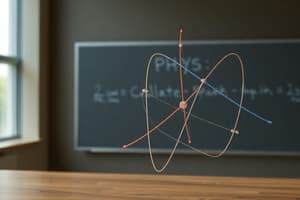Podcast
Questions and Answers
Does dipole moment have a direction (is it a vector quantity)?
Does dipole moment have a direction (is it a vector quantity)?
- a) Yes. Its direction is along a dipole axis from the positive to the negative charge.
- b) No. It's a scalar quantity.
- c) Yes. Its direction is along a dipole axis from the negative to the positive charge. (correct)
- d) Yes. Its direction is perpendicular to a dipole axis.
2.The electric field strength of a dipole, E, is proportional to:
2.The electric field strength of a dipole, E, is proportional to:
- c) E∼r21.
- d) E∼r51.
- a) E∼r1 (where r is the distance from the dipole).
- b) E∼r31. (correct)
3.The impedance of a living tissue is determined by:
3.The impedance of a living tissue is determined by:
- b) Inductance and ohmic resistance.
- c) Electric capacitance and ohmic resistance. (correct)
- d) Ohmic resistance only.
- a) Inductance and electric capacitance.
What is the cause for a decrease of the direct current when it passes through a tissue?
What is the cause for a decrease of the direct current when it passes through a tissue?
5.Calculate the potential of the electric field of a dipole at a distance of 10cm from the dipole perpendicular to the dipole axis (θ=90∘), if it is known that the dipole moment is 0.2C\cdotpm and the medium permittivity is 1 (the constant k=9⋅109N\cdotpm2/C2).
5.Calculate the potential of the electric field of a dipole at a distance of 10cm from the dipole perpendicular to the dipole axis (θ=90∘), if it is known that the dipole moment is 0.2C\cdotpm and the medium permittivity is 1 (the constant k=9⋅109N\cdotpm2/C2).
6.The electric circuit of the Wheatstone's bridge is shown below. What is the relation between the bridge arms' resistances, Rx, R, l1, and l2, when the bridge is in balance?
6.The electric circuit of the Wheatstone's bridge is shown below. What is the relation between the bridge arms' resistances, Rx, R, l1, and l2, when the bridge is in balance?
7.What are the measurement units for the dipole moment?
7.What are the measurement units for the dipole moment?
The measurement units for the electric field potential, ϕ, and electric field strength, E, are:
The measurement units for the electric field potential, ϕ, and electric field strength, E, are:
The main reason for the use of alternating current instead of direct current in the Wheatstone's bridge method of measuring resistances is:
The main reason for the use of alternating current instead of direct current in the Wheatstone's bridge method of measuring resistances is:
10.Calculate the strength of the electric field inside a cell membrane, if it is known that the thickness of the membrane is 5nm and the transmembrane potential is equal to 60mV.
10.Calculate the strength of the electric field inside a cell membrane, if it is known that the thickness of the membrane is 5nm and the transmembrane potential is equal to 60mV.
The carriers of the electric current in an electrolyte are:
The carriers of the electric current in an electrolyte are:
12.How does the strength, E, of the uniform electric field relate to the potential difference, Δϕ?
12.How does the strength, E, of the uniform electric field relate to the potential difference, Δϕ?
13.What is the expression for the potential of the dipole electric field at a remote point of space?
13.What is the expression for the potential of the dipole electric field at a remote point of space?
14.What are the measurement units for the resistivity, ρ?
14.What are the measurement units for the resistivity, ρ?
15The resistivity characterizes:
15The resistivity characterizes:
16.How are interrelated resistance, R, and resistivity, ρ?
16.How are interrelated resistance, R, and resistivity, ρ?
17.How does the living tissue impedance depend on the frequency of the current?
17.How does the living tissue impedance depend on the frequency of the current?
18.Define what is an electric dipole?
18.Define what is an electric dipole?
Calculate the electric resistance of a blood contained in a blood vessel of 10cm long and 2mm2 inner cross-sectional area. The resistivity of the blood is 1.6Ω⋅m.
Calculate the electric resistance of a blood contained in a blood vessel of 10cm long and 2mm2 inner cross-sectional area. The resistivity of the blood is 1.6Ω⋅m.
20.The expression for a living tissue impedance is:
20.The expression for a living tissue impedance is:
Flashcards
Capital of France (example flashcard)
Capital of France (example flashcard)
Paris



